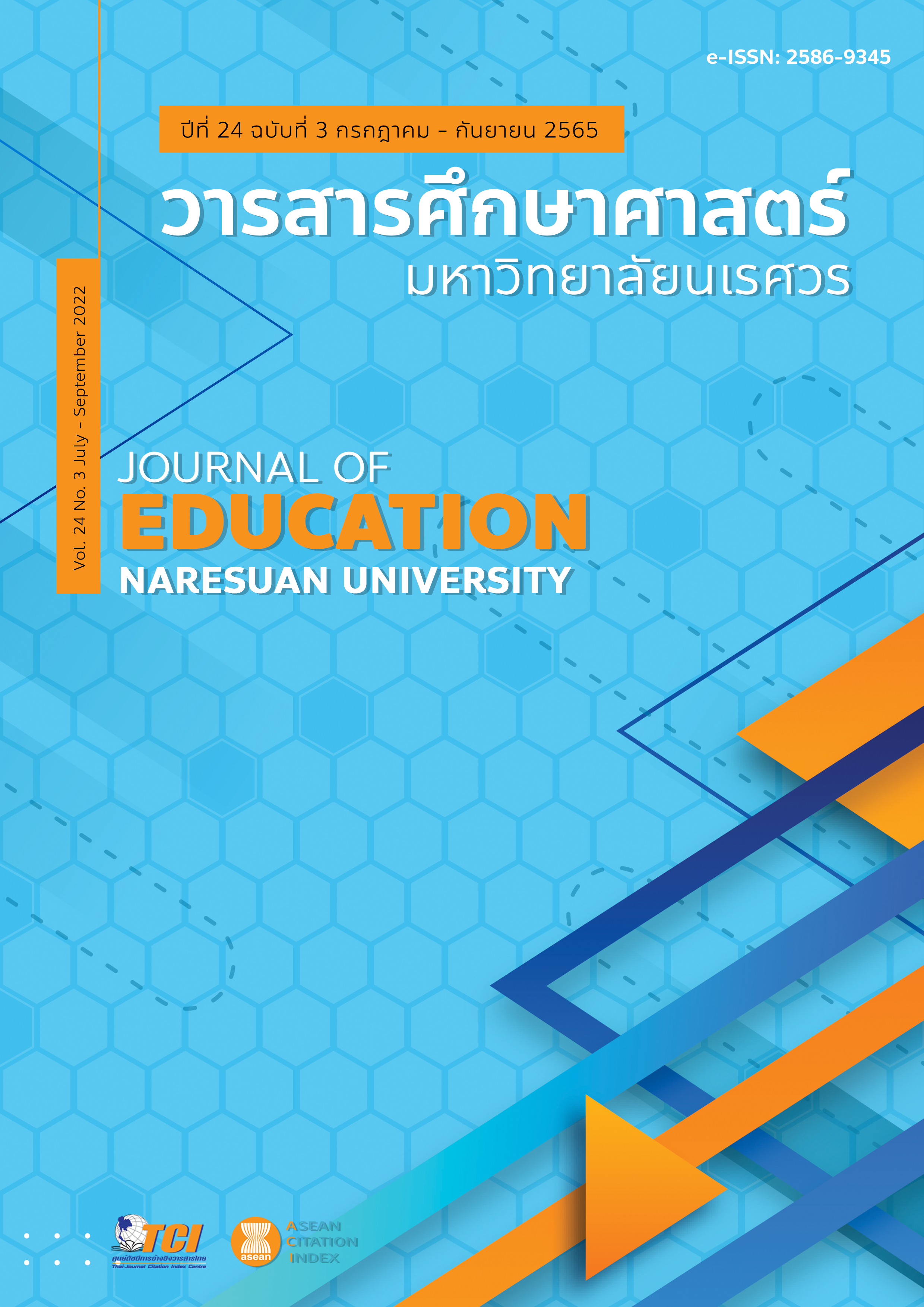THE IMPACT OF GAMIFICATION ON STUDENT ATTITUDES AND LEARNING OUTCOMES IN ENGLISH FOR SELF-DIRECTION COURSE OF THE FIRST-YEAR STUDENTS, SUAN DUSIT UNIVERSITY, LAMPANG CENTER ผลกระทบของการเรียนรู้โดยใช้เทคนิคเกมมิฟิเคชันต่อเจตคติและผลลัพธ์ทางการเรียนรู้ ในรายวิชาภาษาอังกฤษเพื่อการนำตน ของผู้เรียนชั้นปีที่ 1 มหาวิทยาลัยสวนดุสิต ศูนย์การศึกษานอกที่ตั้ง ลำปาง
Main Article Content
Abstract
The objectives of this research were 1) to study the attitude of learners before and after learning management by using the game technique in English for Self-direction course, 2) to compare the learning outcomes of the learners before and after the learning management by using the game technique, and 3) to assess the learners' satisfaction after learning management by using the game technique. The research samples were first-year students of Early Childhood Education and Culinary Technology and Service who enrolled in English for Self-direction course for 37 students. The instrument used in this research consisted of: 1) the attitude test with content validity, showing 0.93 and the reliability of Cronbach alpha coefficient at 0.77, 2) the learning management plan of English for Self-direction course using gamification technique with content validity, representing a mean of 4.42, 3) learning achievement test with difficulties range of 0.64, the discriminating powers range of 0.33 and reliability of Cronbach alpha coefficient of 0.71, and 4) satisfaction assessment form towards learning management by using gamification techniques data with content validity, showing 0.95 and reliability of Cronbach alpha coefficient of 0.92. The statistics for data analysis were mean, standard deviation, percentage, and t-test: paired two sample. The results indicated that the average score of learners’ attitudes towards English learning by using gamification was higher. The mean of attitude test before experiment was 3.50 or 70 percent and it increased to 4.08 or 81.6 percent, ranked a high level after experiment. In terms of learning outcomes, it showed that the learning outcomes of learners after using the gamification technique was higher. The mean of pre-test was 13.76 and the average score of post-test was 30.43. In terms of satisfaction, the overall average score was 4.32 or 86.4 percent, ranked a high level.
Article Details

This work is licensed under a Creative Commons Attribution-NonCommercial-NoDerivatives 4.0 International License.
The owner of the article does not copy or violate any of its copyright. If any copyright infringement occurs or prosecution, in any case, the Editorial Board is not involved in all the rights to the owner of the article to be performed.
References
Allwright, D., & K. M. Bailey. (1991). Focus on the language classroom: An introduction to classroom research for language teachers. Cambridge: Cambridge University Press.
Al-Sobhi, B., Md Rashid, S., & Abdullah, A. N. (2018). Arab ESL secondary school students’ attitude toward English spelling and writing. SAGE Open. https://doi.org/10.1177/2158244018763477
Choosangnil, C. (2018). Gamification: Learn to play as a game. Retrieved 21 December 2018, from https://www.scimath.org/article-technology/item/8669-2018-09-11-08-06-48 [in Thai]
Christopher, P. (2014). How gamification reshapes learning. Retrieved from https://elearningindustry.com/wp-content/uploads/ebooks/gamification.pdf
Dörnyei, Z. (2005). The psychology of the language learner: Individual differences in second language acquisition. New Jersey: Lawrence Erlbaum Associates.
Helms, R. W., Barneveld, R., & Dalpiaz, F. (2015). A method for the design of gamified trainings. In Proceedings of the Pacific Asian Conference on Information Systems: PACIS 2015 [59] AIS Electronic Library. https://aisel.aisnet.org/pacis2015/59/.
Huang, W., & Soman, D. (2013). Gamification of education. Toronto, Canada: University of Toronto.
Hung, H. T. (2017). Clickers in the flipped classroom: bring your own device (BYOD) to promote student learning. Interactive Learning Environments, 25(8), 983-995. Doi: 10.1080/10494820.2016.1240090
Kapp, K. M. (2012) The gamification of learning and instruction: Game based methods and strategies for training and education. John Wiley & Sons.
Khehatham, W. (2014). Satisfaction of students/students using college cafeteria service at Chanthaburi Technical Collage. Chanthaburi: Office of the Vocational Education Commission. [in Thai]
Krause, M., Mogalle, M., Pohl, H., & Williams, J. J. (2015). A Playful Game Changer: Fostering Student Retention in Online Education with Social Gamification. In Proceedings of the second ACM conference on Learning @ scale - L@S '15. https://doi.org/10.1145/2724660.2724665
Kultavanich, K., & Ratanawongsa, R. (2016). A comparative study of opinions and attitudes towards Gamification concept of students undergraduate students. Thai Education System Research (CRTES). [in Thai]
Langphin, K. (2020). Perspectives of learners and teachers for using Kahoot! To motivate the classroom Rajamangala University of Technology Lanna, Chiang Mai. Retrieved May 1, 2020, from http://www.libarts.mju.ac.th/libartsforum1/paper/010520_003146.pdf [in Thai]
Lee, J. J., & Hammer, J. (2011). Gamification in education: What, how, why bother? Academic Exchange Quarterly, 15(2), 1-5.
Liu, T. Y. (2017). Developing an English mobile learning attitude scale for adult learners. Journal of Educational Technology Systems, 45(3), 424–435. doi:10.1177/ 0047239516658448
Macmeekin, M. (2013). Please, I need you to participate. Retrieved from https://anethicalisland.wordpress.com/2013/03/28/please-i-need-you-to-participate/
Olenka Bilash Bio. 2009. Positive attitude. Retrieved from https://sites.educ.ualberta.ca/staff/olenka.bilash/Best%20of%20Bilash/positiveattitude.html
Pertaub, D. P., Slater, M., & Barker, C. (2001). An experiment on public speaking anxiety in response to three different types of virtual audience. Teleoperators and Virtual Environments, 11(1), 68-78.
Robson, K., Plagger, K., Kietzmann, J. H. McCarthy, I., & Pitt, L. (2015). Is it all a game? Understanding the principles of gamification. Business Horizon, 58(4), 411-420.
Rosmawati, D., & Juhari, S. J. (2018). Gamification of Kahoot! boosts students’ motivation in ESL classroom. Retrieved October, 17, 2018, from https://www.researchgate.net/publication/328342175_Gamification_of_Kahoot_Boosts_Students'_Motivation_in_ESL_Classroom
Saengprasert, W. (2020). Results of Reading Teaching Using Gamification on Reading Achievement. English for understanding and mind Motto towards reading teaching of high school students. The 10th STOU National Research Conference. Retrieved from https://www.stou.ac.th/thai/grad [in Thai]
Simões, J., Redondo, R. D., & Vilas, A. F. (2013). A social gamification framework for a K-6 learning platform. Computers in Human Behavior, 29, 345–353.
Trakulkasemsuk, P. (2015). Application of video game format in learning teach on behavioral development attending class participation and achievement attention of undergraduate students. The 9th Hatyai National and International Conference. Songkhla: Hatyai University. [in Thai]


